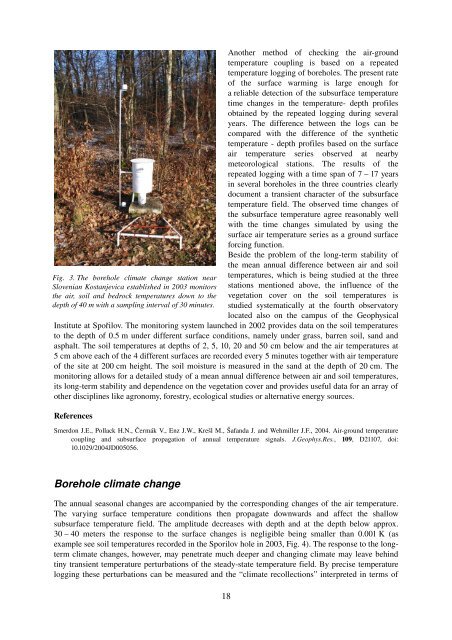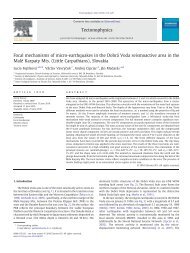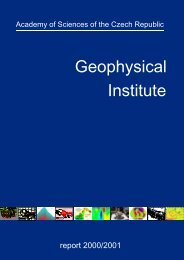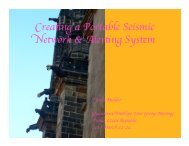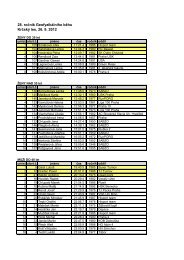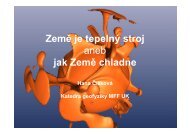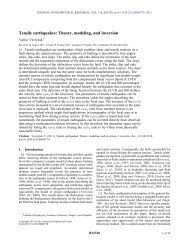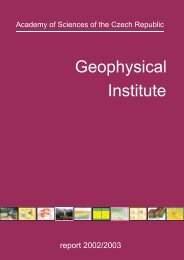Geophysical Institute of the ASCR
Geophysical Institute of the ASCR
Geophysical Institute of the ASCR
Create successful ePaper yourself
Turn your PDF publications into a flip-book with our unique Google optimized e-Paper software.
Fig. 3. The borehole climate change station near<br />
Slovenian Kostanjevica established in 2003 monitors<br />
<strong>the</strong> air, soil and bedrock temperatures down to <strong>the</strong><br />
depth <strong>of</strong> 40 m with a sampling interval <strong>of</strong> 30 minutes.<br />
Ano<strong>the</strong>r method <strong>of</strong> checking <strong>the</strong> air-ground<br />
temperature coupling is based on a repeated<br />
temperature logging <strong>of</strong> boreholes. The present rate<br />
<strong>of</strong> <strong>the</strong> surface warming is large enough for<br />
a reliable detection <strong>of</strong> <strong>the</strong> subsurface temperature<br />
time changes in <strong>the</strong> temperature- depth pr<strong>of</strong>iles<br />
obtained by <strong>the</strong> repeated logging during several<br />
years. The difference between <strong>the</strong> logs can be<br />
compared with <strong>the</strong> difference <strong>of</strong> <strong>the</strong> syn<strong>the</strong>tic<br />
temperature - depth pr<strong>of</strong>iles based on <strong>the</strong> surface<br />
air temperature series observed at nearby<br />
meteorological stations. The results <strong>of</strong> <strong>the</strong><br />
repeated logging with a time span <strong>of</strong> 7 – 17 years<br />
in several boreholes in <strong>the</strong> three countries clearly<br />
document a transient character <strong>of</strong> <strong>the</strong> subsurface<br />
temperature field. The observed time changes <strong>of</strong><br />
<strong>the</strong> subsurface temperature agree reasonably well<br />
with <strong>the</strong> time changes simulated by using <strong>the</strong><br />
surface air temperature series as a ground surface<br />
forcing function.<br />
Beside <strong>the</strong> problem <strong>of</strong> <strong>the</strong> long-term stability <strong>of</strong><br />
<strong>the</strong> mean annual difference between air and soil<br />
temperatures, which is being studied at <strong>the</strong> three<br />
stations mentioned above, <strong>the</strong> influence <strong>of</strong> <strong>the</strong><br />
vegetation cover on <strong>the</strong> soil temperatures is<br />
studied systematically at <strong>the</strong> fourth observatory<br />
located also on <strong>the</strong> campus <strong>of</strong> <strong>the</strong> <strong>Geophysical</strong><br />
<strong>Institute</strong> at Spořilov. The monitoring system launched in 2002 provides data on <strong>the</strong> soil temperatures<br />
to <strong>the</strong> depth <strong>of</strong> 0.5 m under different surface conditions, namely under grass, barren soil, sand and<br />
asphalt. The soil temperatures at depths <strong>of</strong> 2, 5, 10, 20 and 50 cm below and <strong>the</strong> air temperatures at<br />
5 cm above each <strong>of</strong> <strong>the</strong> 4 different surfaces are recorded every 5 minutes toge<strong>the</strong>r with air temperature<br />
<strong>of</strong> <strong>the</strong> site at 200 cm height. The soil moisture is measured in <strong>the</strong> sand at <strong>the</strong> depth <strong>of</strong> 20 cm. The<br />
monitoring allows for a detailed study <strong>of</strong> a mean annual difference between air and soil temperatures,<br />
its long-term stability and dependence on <strong>the</strong> vegetation cover and provides useful data for an array <strong>of</strong><br />
o<strong>the</strong>r disciplines like agronomy, forestry, ecological studies or alternative energy sources.<br />
References<br />
Smerdon J.E., Pollack H.N., Čermák V., Enz J.W., Krešl M., Šafanda J. and Wehmiller J.F., 2004. Air-ground temperature<br />
coupling and subsurface propagation <strong>of</strong> annual temperature signals. J.Geophys.Res., 109, D21107, doi:<br />
10.1029/2004JD005056.<br />
Borehole climate change<br />
The annual seasonal changes are accompanied by <strong>the</strong> corresponding changes <strong>of</strong> <strong>the</strong> air temperature.<br />
The varying surface temperature conditions <strong>the</strong>n propagate downwards and affect <strong>the</strong> shallow<br />
subsurface temperature field. The amplitude decreases with depth and at <strong>the</strong> depth below approx.<br />
30 – 40 meters <strong>the</strong> response to <strong>the</strong> surface changes is negligible being smaller than 0.001 K (as<br />
example see soil temperatures recorded in <strong>the</strong> Sporilov hole in 2003, Fig. 4). The response to <strong>the</strong> longterm<br />
climate changes, however, may penetrate much deeper and changing climate may leave behind<br />
tiny transient temperature perturbations <strong>of</strong> <strong>the</strong> steady-state temperature field. By precise temperature<br />
logging <strong>the</strong>se perturbations can be measured and <strong>the</strong> “climate recollections” interpreted in terms <strong>of</strong><br />
18


